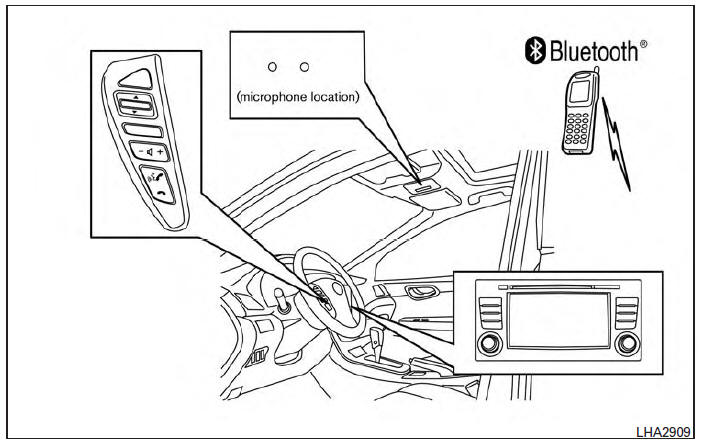Nissan Sentra Owners Manual: BluetoothÂź Hands-Free Phone System with Navigation System (if so equipped)
WARNING
|
CAUTION
To avoid discharging the vehicle battery, use a phone after starting the engine.

Your NISSAN is equipped with the BluetoothÂź Hands-Free Phone System. If you have a compatible BluetoothÂź enabled cellular phone, you can set up the wireless connection between your cellular phone and the in-vehicle phone module.
With BluetoothÂź wireless technology, you can make or receive a hands-free telephone call with your cellular phone in the vehicle.
Once your cellular phone is connected to the in-vehicle phone module, no other phone connecting procedure is required. Your phone is automatically connected with the in-vehicle phone module when the ignition switch is placed in the ON position with the connected cellular phone turned on and carried in the vehicle.
You can register up to 5 different BluetoothÂź cellular phones to the in-vehicle phone module.
However, you can talk on only one cellular phone at a time.
NISSAN Voice Recognition system supports the phone commands, so dialing a phone number using your voice is possible. For more details, see âNISSAN Voice Recognition Systemâ in this section.
Before using the BluetoothÂź Hands-Free Phone System, refer to the following notes.
- Set up the wireless connection between a cellular phone and the in-vehicle phone module before using the hands-free phone system.
- Some BluetoothÂź enabled cellular phones may not be recognized by the in-vehicle phone module. Please visit www.nissanusa.com/bluetooth for a recommended phone list and connecting.
- You will not be able to use a hands-free phone under the following conditions:
- Your vehicle is outside of the cellular service area.
- Your vehicle is in an area where it is difficult to receive cellular signal; such as in a tunnel, in an underground parking garage, near a tall building or in a mountainous area.
- Your cellular phone is locked to prevent it from being dialed.
- When the radio wave condition is not ideal or ambient sound is too loud, it may be difficult to hear the other personâs voice during a call.
- Immediately after the ignition switch is placed in the ON position, it may be impossible to receive a call for a short period of time.
- Do not place the cellular phone in an area surrounded by metal or far away from the in-vehicle phone module to prevent tone quality degradation and wireless connection disruption.
- While a cellular phone is connected through the BluetoothÂź wireless connection, the battery power of the cellular phone may discharge quicker than usual. The BluetoothÂź Hands-Free Phone System cannot charge cellular phones.
- If the hands-free phone system seems to be malfunctioning, see âTroubleshooting guideâ in this section. You can also visit www.nissanusa.com/bluetooth for troubleshooting help.
- Some cellular phones or other devices may cause interference or a buzzing noise to come from the audio system speakers. Storing the device in a different location may reduce or eliminate the noise.
- Refer to the cellular phone ownerâs manual regarding the telephone charges, cellular phone antenna and body, etc.
- The signal strength display on the monitor will not coincide with the signal strength display of some cellular phones.
- Regulatory Information
- Voice commands
- Connecting Procedure
- Vehicle phonebook
- Making a call
- Receiving a call
- During a call
- Text messaging
- BluetoothÂź settings
- Phone settings
 Manual control
Manual control
While using the Voice Recognition system, it is
possible to select menu options by using the
steering wheel controls instead of speaking voice
commands. The manual control mode does not
allow dial ...
 Regulatory Information
Regulatory Information
FCC Regulatory information
CAUTION: To maintain compliance with
FCCâs RF exposure guidelines, use only the
supplied antenna. Unauthorized antenna,
modification, or attachments could damage ...
Other materials:
Rear window defogger relay
Description
Power is supplied to the rear window defogger with BCM control.
Component Function Check
1. Check rear window defogger relay power supply circuit
Turn ignition switch ON.
Check that an operation noise of rear window defogger relay (located in
IPDM E/R) can be heard when
t ...
Diagnosis system (ipdm e/r) (without intelligent key system)
Diagnosis Description
AUTO ACTIVE TEST
Description
In auto active test, the IPDM E/R sends a drive signal to the following
systems to check their operation.
Front wiper (LO, HI)
Parking lamp
License plate lamp
Tail lamp
Front fog lamp (if equipped)
Headlamp (LO, HI)
A/C compres ...
Heater operation
This mode is used to direct heated air to the foot
outlets. Some air also flows from the defrost
outlets and the side vent outlets.
Press the button to the OFF
position
for normal heating.
Press the air flow control
button.
Turn the fan control dial to the desired position.
Tur ...
